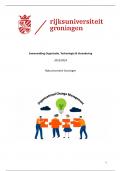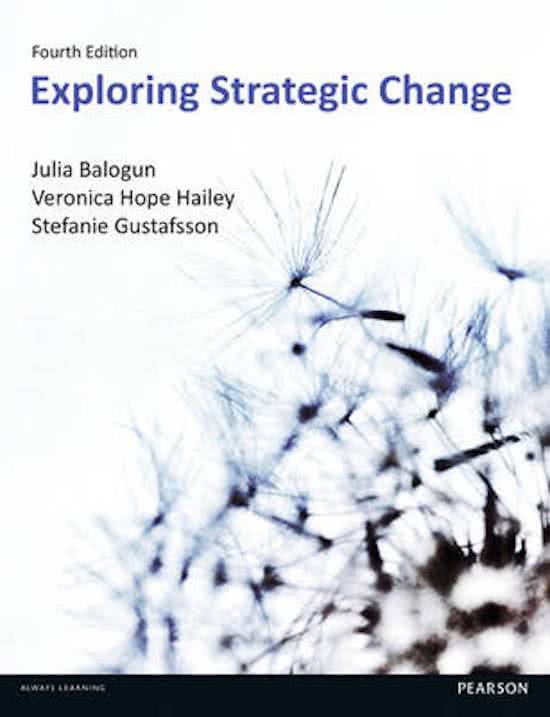Samenva(ng Organisa.e, Technologie & Verandering
2023/2024
Rijksuniversiteit Groningen
1
, Inhoudsopgave
Week 1: Boek Hoofdstuk 1 & 2 en ar4kelen .................................................................................................... 3
Hoofdstuk 1 – Exploring strategic change: An introduc:on................................................................................ 3
Hoofdstuk 2 – Understanding implementa:on choices: the change path .......................................................... 7
Lyy:nen, K., & Newman, M. 2008. Explaining informa:on systems change: a punctuated socio-technical
change model. European Journal of Informa:on Systems, 17: 589-613........................................................... 10
KoRer J.P. & Schlesinger, L.A. 2008/1979. Choosing strategies for change. Harvard Business Review, 86: 130-
139. ................................................................................................................................................................... 11
Shao, Z., Feng, Y., & Hu, Q. 2016. Effec:veness of top management support in enterprise systems success: a
con:ngency perspec:ve of fit between leadership style and system life-cycle. European Journal of
Informa:on Systems, 25(2): 131-153................................................................................................................ 14
Week 2: Boek Hoofdstuk 3 & 4, ar4kelen ...................................................................................................... 16
Hoofdstuk 3 – Understanding implementa:on choices: The addi:onal op:ons to consider ............................ 16
Hoofdstuk 4 – Analyzing the change context: how context affects choice........................................................ 21
Van Offenbeek, M.A.G., Boonstra, A., & Seo, D. 2013. Towards integra:ng acceptance and resistance
research: evidence from a telecare case study. European Journal of Informa:on Systems, 22(4): 434-454. ... 25
KoRer, J.P. 2007/1995. Leading Change. Why Transforma:on efforts fail. Harvard Business Review, 85: 96-
103. ................................................................................................................................................................... 27
Beaudry, A., & Pinsonneault, A. 2005. Understanding user responses to informa:on technology: a coping
model of user adapta:on. MIS Quarterly, 29(3): 493-524. ............................................................................... 28
Week 4: Boek Hoofdstuk 4 & 5, ar4kel .......................................................................................................... 30
Hoofdstuk 5 – Designing the transi:on: the implementa:on path .................................................................. 30
Vos, J. F.J, & Rupert, J. 2018. Change agent's contribu:on to recipients' resistance to change: A two-sided
story. European Management Journal, 36(4): 453-462. ................................................................................... 35
Week 6: Hoofdstuk 6, 7 & 8, ar4kelen ........................................................................................................... 37
Hoofdstuk 6 – Transi:on management: building enabling condi:ons for change ........................................... 37
Hoofdstuk 7 – Transi:on management: employee engagement, trust, jus:ce and voice ................................ 43
Hoofdstuk 8 – Concluding comments ............................................................................................................... 47
Wee, E.X.M. & Taylor, M.S. 2018. ARen:on to change: a mul:level theory on the process of emergent
con:nuous organiza:onal change. Journal of Applied Psychology, 103(1): 1- 13. ........................................... 48
Ford, J.D., & Ford, L.W. 2010. Stop blaming resistance to change and start using it. Organiza:onal Dynamics,
39(1): 24-36. ..................................................................................................................................................... 50
Lyy:nen, K., & Newman, M. 2015. A tale of two coali:ons – marginalising the users while successfully
implemen:ng an enterprise resource planning system. Informa:on Systems Journal, 15(2): 71-101 ............. 51
2
, Week 1: Boek Hoofdstuk 1 & 2 en ar.kelen
Hoofdstuk 1 – Exploring strategic change: An introduc:on
Change management has become a highly sought-a4er managerial competence.
The senior manager role in strategic change has two components:
- Externally focused: Senior managers need to devise strategies that promise strategic
fit with the external environment and some form of compeBBve advantage (strategic
thinking)
- Internally focused: working internally to bring the organizaBon in line with that
promise à aligning the organizaBon behind the intended strategy (strategic ac8ng)
Exploring Strategic Change takes up this challenge with a focus on the linking of strategic
thinking and strategic acBng to enable the realizaBon of intended strategies.
Strategic/transforma8onal change: descripBve of magnitude in alteraBon in, for example, the
culture, strategy, and structure of the firm, recognizing the second order effects, or mulBple
consequences of any such change.
Two schools of thought about how change occurs in organizaBons:
1. The first sees change as con8nuous, with organizaBons transforming on an on-going
basis to keep pace with their changing environment
2. The second sees change as a process of punctuated equilibrium. From this
perspecBve, organizaBons evolve through relaBvely long periods of stability (periods of
evoluBonary and incremental convergent change) that are then interspersed by shorter
periods of more fundamental revoluBonary change.
3
, - Convergent change is adaptaBon within the exisBng way of doing things – it leads to
extension and conBnuity of the past. à Incremental, may be slower. In industries
where constant organizaBonal change is necessary for survival.
- Revolu8onary change is transformaBonal change achieved through a simultaneous
change in the strategy, structure, systems and culture of an organizaBon leading to a
radically different way of operaBng. à likely to be reacBve and forced by an impending
crisis.
Strategic driA: This term captures the noBon that even as senior managers conBnue to exploit
the capabiliBes and sources of performance and advantage that have delivered success for
their organizaBon in the past, they will engage in some level of change.
à a gap between what the organizaBon is doing and what it needs to be doing to be
compeBBve in its market place. à performance starts to decline
Undertaking a step change in a:
- Proac8ve manner in recogniBon of the need for pre-empBve change given potenBal
threats that may arise in the future or are currently arising
- Reac8ve manner in response to an immediate need, such as a new direct compeBBve
threat or increasing under performance as dri4 sets in.
The focus is on inten8onal, planned change: change circumstances in which the leaders of an
organisaBon have examined their strategic posiBon and deliberately formulated a new strategy
which requires the organisaBon, and the people within it, to operate differently in some way.
The skill of change agency lies in having the competence to assess where an organisaBon is
strategically, and the nature of the strategic change design required.
4






